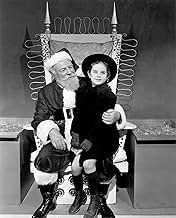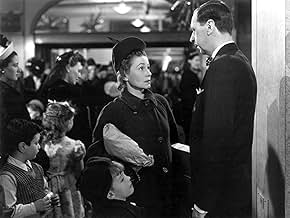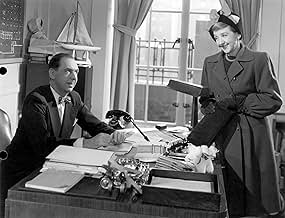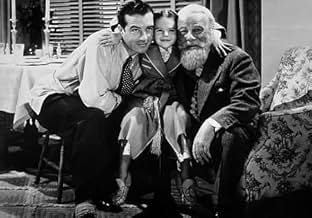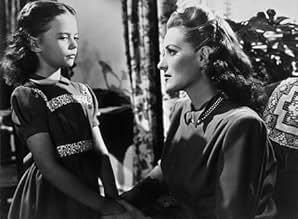VALUTAZIONE IMDb
7,9/10
58.217
LA TUA VALUTAZIONE
Quando un simpatico vecchietto sostiene di essere Babbo Natale, viene internato e considerato pazzo, un giovane avvocato decide di difenderlo.Quando un simpatico vecchietto sostiene di essere Babbo Natale, viene internato e considerato pazzo, un giovane avvocato decide di difenderlo.Quando un simpatico vecchietto sostiene di essere Babbo Natale, viene internato e considerato pazzo, un giovane avvocato decide di difenderlo.
- Regia
- Sceneggiatura
- Star
- Vincitore di 3 Oscar
- 10 vittorie e 1 candidatura in totale
Jack Albertson
- Post Office Mail Sorter Next to Lou
- (non citato nei titoli originali)
Harry Antrim
- Mr. R.H. Macy
- (non citato nei titoli originali)
Arline Bletcher
- Courtroom Spectator
- (non citato nei titoli originali)
Lela Bliss
- Mrs. Shellhammer
- (non citato nei titoli originali)
Symona Boniface
- Courtroom Spectator
- (non citato nei titoli originali)
Walden Boyle
- Judge's Clerk
- (non citato nei titoli originali)
Kevin Burke
- Child on Santa's Lap
- (non citato nei titoli originali)
Dorothy Christy
- Secretary
- (non citato nei titoli originali)
Dick Cogan
- Department Store Head
- (non citato nei titoli originali)
Recensioni in evidenza
...............Santa Claus has come to town. Or at least that's what a gentlemen appropriately named Kristopher Kringle played by Edmund Gwenn complete with full white beard is claiming. He makes his appearance at the Thanksgiving Day Parade as sponsored by R.H. Macy's Department Store and finds the Santa hired for the occasion, Percy Helton, full of a little too much Christmas cheer already. In charge of the parade is one of Macy's middle level executives, Maureen O'Hara, who fires Helton and hires Gwenn right then and there.
Gwenn's obvious sincerity makes him an ideal Santa Claus for Macy's and for us. He spreads the real meaning of Christmas around even has Macy's declaring a holiday truce with its rival Gimbel's. That's a part of Miracle on 34th Street that might be lost to viewers today. Gimbel's was Macy's big department store rival and it's flagship store in New York stood across 34th Street at the time. Gives a meaning to the title that is lost on today's audience.
But wiser and more sophisticated folks like the majority of us know there ain't no such thing as Santa Claus. Even Maureen O'Hara knows that and imparts it to her daughter Natalie Wood. Gwenn's just a kind old man in a white beard. But when his sanity is questioned, Gwenn's belief becomes a matter for the courts where Gwenn is ably defended by O'Hara's boyfriend, lawyer John Payne.
Like that other holiday classic It's A Wonderful Life, Christmas is never complete without seeing Miracle on 34th Street. Though New York has changed considerably since 1947 the year I made my earthly debut, the film has lost absolutely none of its charm.
Edmund Gwenn won the Best Supporting Actor of 1947 and in doing so, beat out his best friend, Finlay Currie, who was up that year for playing Magwitch in Great Expectations. The two had met in stock companies in their native Scotland and were friends right up to when Gwenn passed away in 1959. The Oscar was the high point of his career.
Maureen O'Hara in her memoirs says that Miracle on 34th Street holds a special place in her affections. In fact until Gwenn died, she had hopes of doing some kind of sequel. She bonded on stage with young Natalie Wood who later played her daughter in Father Was A Fullback also and kept in contact with her right up to her death in 1981.
Maureen also had a deep affection for John Payne who she made four films with and says was one of the nicest men in the world. One story she related was on the set of another film they made, Payne was served with divorce papers right on the set from his then wife, Anne Shirley. She said he broke down and cried like a baby. If it weren't for the fact she was married, she said she definitely could have gotten something going with Payne.
In the supporting cast note the presence of one grinch in the person of Porter Hall who played one of his patented nasty little meanies. His meddling and general misanthropy cause Gwenn to have that trial in the first place. Look for a bit role from Jack Albertson as the postal employee who inadvertently saves the day. Also making her film debut is Thelma Ritter as the mother of a child looking to meet Santa Claus, the one official Santa Claus, courtesy of Macy's Department Store.
Although Miracle on 34th Street has been remade several times over the years, this one is the genuine article. As genuine as the fact that Macy's has the official Santa Claus as certified by a higher authority.
One thing has always puzzled me though. How long did it take Edmund Gwenn to grow that beard for the part?
Gwenn's obvious sincerity makes him an ideal Santa Claus for Macy's and for us. He spreads the real meaning of Christmas around even has Macy's declaring a holiday truce with its rival Gimbel's. That's a part of Miracle on 34th Street that might be lost to viewers today. Gimbel's was Macy's big department store rival and it's flagship store in New York stood across 34th Street at the time. Gives a meaning to the title that is lost on today's audience.
But wiser and more sophisticated folks like the majority of us know there ain't no such thing as Santa Claus. Even Maureen O'Hara knows that and imparts it to her daughter Natalie Wood. Gwenn's just a kind old man in a white beard. But when his sanity is questioned, Gwenn's belief becomes a matter for the courts where Gwenn is ably defended by O'Hara's boyfriend, lawyer John Payne.
Like that other holiday classic It's A Wonderful Life, Christmas is never complete without seeing Miracle on 34th Street. Though New York has changed considerably since 1947 the year I made my earthly debut, the film has lost absolutely none of its charm.
Edmund Gwenn won the Best Supporting Actor of 1947 and in doing so, beat out his best friend, Finlay Currie, who was up that year for playing Magwitch in Great Expectations. The two had met in stock companies in their native Scotland and were friends right up to when Gwenn passed away in 1959. The Oscar was the high point of his career.
Maureen O'Hara in her memoirs says that Miracle on 34th Street holds a special place in her affections. In fact until Gwenn died, she had hopes of doing some kind of sequel. She bonded on stage with young Natalie Wood who later played her daughter in Father Was A Fullback also and kept in contact with her right up to her death in 1981.
Maureen also had a deep affection for John Payne who she made four films with and says was one of the nicest men in the world. One story she related was on the set of another film they made, Payne was served with divorce papers right on the set from his then wife, Anne Shirley. She said he broke down and cried like a baby. If it weren't for the fact she was married, she said she definitely could have gotten something going with Payne.
In the supporting cast note the presence of one grinch in the person of Porter Hall who played one of his patented nasty little meanies. His meddling and general misanthropy cause Gwenn to have that trial in the first place. Look for a bit role from Jack Albertson as the postal employee who inadvertently saves the day. Also making her film debut is Thelma Ritter as the mother of a child looking to meet Santa Claus, the one official Santa Claus, courtesy of Macy's Department Store.
Although Miracle on 34th Street has been remade several times over the years, this one is the genuine article. As genuine as the fact that Macy's has the official Santa Claus as certified by a higher authority.
One thing has always puzzled me though. How long did it take Edmund Gwenn to grow that beard for the part?
This is certainly a lovely warmhearted movie, but since other reviewers have described the plot in detail, I'll move on to other topics.
I love movies like this for the insight they provide into the customs of a lost era. Watch the clothing - everybody is so dressed up! - women in dresses, gloves, and hats, men in hats and suits. Notice that when O'Hara enters a room filled with Macy's executives, even though they are the bosses and she is lower management, they all stand up instantly.
The social satire, most on display in the courtroom scenes, also is very 1940s. Apparently audiences of that era took a kind of genial corruption in the judicial system in stride. Business leaders, like "Mr. Macy" were expected to be sharp and profit-oriented, but also decent people like the rest of us. It's a much more nuanced view than the "businessman as criminal villain" so common in today's movies.
The character played by Maureen O'Hara probably needs explanation for modern viewers. Late 1940s audiences knew that the social and economic situation of a divorced working woman with a child was much more precarious than it is now. Divorce was still somewhat shocking - this is brought out neatly in the movie when her would-be lover does a double take when he learns from her daughter about the divorce - he probably had assumed she was a war widow. Divorced moms were still rare in the middle classes. Society universally agreed that women should stay home to raise their children. Economically, women in management positions were still very rare, couldn't expect promotion, and were last hired, first fired. I think O'Hara's performance brings out these qualities in a way that the audience of the 1940s would have understood easily. The character's stiffness, fear of losing control, and anxiety about her job make a great deal of sense. It would have been nice to see a few scenes showing her loosening up, perhaps at dinner with her boyfriend; no doubt those got left on the cutting room floor.
I really like the scene where Santa talks to the little Dutch orphan. First, this scene also must have resonated with the audience; in 1947 the western European countries had only started to recover from World War II, and probably many Americans were familiar with the idea of adopting a war orphan, just as many sent CARE packages. Second, by making Santa fluent in Dutch, the writer cleverly left the viewer thinking that hey, he might really be Santa Claus (isn't Santa Claus fluent in all languages)?
Some reviewers don't like the acting and think that modern actors are "better". I think the older actors aren't better or worse, just different. The audiences of the 1940s expected a certain style of acting, and the directors and actors gave that to them. Then as now, Hollywood paid top dollar and got very talented people, but like all of us they were shaped by their own time and place, more particularly the requirement to make movies that audiences would like. Move Maureen O'Hara to 2004, or Tom Cruise to 1947, and you'd see them acting in the style of that decade.
I love movies like this for the insight they provide into the customs of a lost era. Watch the clothing - everybody is so dressed up! - women in dresses, gloves, and hats, men in hats and suits. Notice that when O'Hara enters a room filled with Macy's executives, even though they are the bosses and she is lower management, they all stand up instantly.
The social satire, most on display in the courtroom scenes, also is very 1940s. Apparently audiences of that era took a kind of genial corruption in the judicial system in stride. Business leaders, like "Mr. Macy" were expected to be sharp and profit-oriented, but also decent people like the rest of us. It's a much more nuanced view than the "businessman as criminal villain" so common in today's movies.
The character played by Maureen O'Hara probably needs explanation for modern viewers. Late 1940s audiences knew that the social and economic situation of a divorced working woman with a child was much more precarious than it is now. Divorce was still somewhat shocking - this is brought out neatly in the movie when her would-be lover does a double take when he learns from her daughter about the divorce - he probably had assumed she was a war widow. Divorced moms were still rare in the middle classes. Society universally agreed that women should stay home to raise their children. Economically, women in management positions were still very rare, couldn't expect promotion, and were last hired, first fired. I think O'Hara's performance brings out these qualities in a way that the audience of the 1940s would have understood easily. The character's stiffness, fear of losing control, and anxiety about her job make a great deal of sense. It would have been nice to see a few scenes showing her loosening up, perhaps at dinner with her boyfriend; no doubt those got left on the cutting room floor.
I really like the scene where Santa talks to the little Dutch orphan. First, this scene also must have resonated with the audience; in 1947 the western European countries had only started to recover from World War II, and probably many Americans were familiar with the idea of adopting a war orphan, just as many sent CARE packages. Second, by making Santa fluent in Dutch, the writer cleverly left the viewer thinking that hey, he might really be Santa Claus (isn't Santa Claus fluent in all languages)?
Some reviewers don't like the acting and think that modern actors are "better". I think the older actors aren't better or worse, just different. The audiences of the 1940s expected a certain style of acting, and the directors and actors gave that to them. Then as now, Hollywood paid top dollar and got very talented people, but like all of us they were shaped by their own time and place, more particularly the requirement to make movies that audiences would like. Move Maureen O'Hara to 2004, or Tom Cruise to 1947, and you'd see them acting in the style of that decade.
REVIEW DATE 2/19/2018
PLEASE BEWARE OF SOME REVIEWERS THAT ONLY HAVE ONLY ONE REVIEW. I HAVE OVER 400 REVIEWS OF "CHRISTMAS RELATED FILMS & SPECIALS" WHEN ITS A POSITIVE THERE IS A GOOD CHANCE THEY WERE INVOLVED WITH THE PRODUCTION. NOW I HAVE NO AGENDA! I REVIEW MOVIES & SPECIALS AS A WAY TO KEEP TRACK OF WHAT I HAVE SEEN! I HAVE DISCOVERED MANY GEMS IN MY QUEST TO SEE AS MANY " C H R I S T M A S " MOVIES AS I CAN.
Now Someone keeps reporting my reviews. I guess they are jealous because I do tell the truth. I want to point out that I never make snide remarks about actors weight or real life sexual orientation. If there acting is terrible or limited "I talk about that". If a story is bad "I will mention that" So why am I being "picked on"? IMDB? When one of my reviews gets deleted IMDB will not even tell me what someone found offensive. Well on to this review.
Kris Kringle (Edmund Gwenn) is indignant to find that the man (Percy Helton) assigned to play Santa in the annual Macy's Thanksgiving Day Parade is intoxicated. When he complains to event director Doris Walker (Maureen O'Hara), she persuades Kris to take his place. He does so well, he is hired to play Santa at Macy's flagship New York City store on 34th Street.
Ignoring instructions to steer parents to buy from Macy's, Kris directs one shopper (Thelma Ritter) to a competitor. Impressed, she tells Julian Shellhammer (Philip Tonge), head of the toy department, that she will become a loyal customer.
Attorney Fred Gailey (John Payne), Doris's neighbor, takes the young divorcée's daughter Susan (Natalie Wood) to see Santa. Doris has raised her to not believe in fairy tales, but Susan is shaken after seeing Kris speak Dutch with a girl who does not know English. Doris asks Kringle to tell Susan that he is not Santa, but he insists that he is.
Worried, Doris decides to fire him. However, Kris has generated so much positive publicity and goodwill for Macy's that Macy (Harry Antrim) promises Doris and Julian bonuses. To alleviate Doris's misgivings, Julian has Granville Sawyer (Porter Hall) administer a "psychological evaluation". Kris passes, and questions Sawyer's own mental health.
This is a great film that everyone should see.
PLEASE BEWARE OF SOME REVIEWERS THAT ONLY HAVE ONLY ONE REVIEW. I HAVE OVER 400 REVIEWS OF "CHRISTMAS RELATED FILMS & SPECIALS" WHEN ITS A POSITIVE THERE IS A GOOD CHANCE THEY WERE INVOLVED WITH THE PRODUCTION. NOW I HAVE NO AGENDA! I REVIEW MOVIES & SPECIALS AS A WAY TO KEEP TRACK OF WHAT I HAVE SEEN! I HAVE DISCOVERED MANY GEMS IN MY QUEST TO SEE AS MANY " C H R I S T M A S " MOVIES AS I CAN.
Now Someone keeps reporting my reviews. I guess they are jealous because I do tell the truth. I want to point out that I never make snide remarks about actors weight or real life sexual orientation. If there acting is terrible or limited "I talk about that". If a story is bad "I will mention that" So why am I being "picked on"? IMDB? When one of my reviews gets deleted IMDB will not even tell me what someone found offensive. Well on to this review.
Kris Kringle (Edmund Gwenn) is indignant to find that the man (Percy Helton) assigned to play Santa in the annual Macy's Thanksgiving Day Parade is intoxicated. When he complains to event director Doris Walker (Maureen O'Hara), she persuades Kris to take his place. He does so well, he is hired to play Santa at Macy's flagship New York City store on 34th Street.
Ignoring instructions to steer parents to buy from Macy's, Kris directs one shopper (Thelma Ritter) to a competitor. Impressed, she tells Julian Shellhammer (Philip Tonge), head of the toy department, that she will become a loyal customer.
Attorney Fred Gailey (John Payne), Doris's neighbor, takes the young divorcée's daughter Susan (Natalie Wood) to see Santa. Doris has raised her to not believe in fairy tales, but Susan is shaken after seeing Kris speak Dutch with a girl who does not know English. Doris asks Kringle to tell Susan that he is not Santa, but he insists that he is.
Worried, Doris decides to fire him. However, Kris has generated so much positive publicity and goodwill for Macy's that Macy (Harry Antrim) promises Doris and Julian bonuses. To alleviate Doris's misgivings, Julian has Granville Sawyer (Porter Hall) administer a "psychological evaluation". Kris passes, and questions Sawyer's own mental health.
This is a great film that everyone should see.
What's wonderful about 'Miracle On 34th Street (1947)' - and this isn't something I realised until after it had finished - is that it never actually provides a definitive answer as to whether Kris Kringle really is the Santa Claus. Personally, I took it as fact from the moment he walked into frame, but I'm pretty sure that was due to my preconceptions surrounding the plot of the picture (Santa goes to court to prove his existence). Thinking back, I had no definitive reason to think that. The absolute ambiguity of the film's central dilemma is brilliant because it forces the viewer to engage with the question that's on almost every characters' lips: is this the real Santa or is it just a kind old man who thinks he's the real Santa? In turn, this allows the movie's theme of belief to transcend its boundaries and truly take root in the audience. Whether you choose to believe in Santa, whether you choose to have faith in him, whether you choose to accept the unacceptable is entirely up to you. As such, it's that much more magical if you do. It's really impressive that the picture can actually use its ambiguity to this effect, especially that it can do so while remaining wholesome and sincere throughout. This charming Christmas tale is enjoyable from beginning to end and it holds up remarkably well seventy-five years after its initial release. It's a delightful experience overall.
Still among the most worthwhile of the familiar holiday movies, this classic version of "Miracle on 34th Street" has a combination of cast, story, and production that works well. Maureen O'Hara, young Natalie Wood, and Edmund Gwenn would probably have carried it pretty well by themselves, and they are joined by a very good supporting cast. The screenplay is nicely done, bringing out the fantasy elements of the story without letting it become trite.
Gwenn, who played many solid character roles, gets the chance here to play a role for which he was ideally suited, and it works very well. O'Hara and Wood make a good pair to balance him out. The supporting cast gets some very good moments of their own, especially Gene Lockhart and William Frawley, whose scenes are entertaining while also offering some occasionally pointed commentary.
The style of the production is well-suited to the material, offering an innocently upbeat story without overdoing it on sentimentality. For all that this style of the production and acting are out of fashion, they are able to capture a theme like this in a worthwhile way that is simply not possible with the kind of false "sophistication" that permeates so many present-day movies.
That's not to say that this is some kind of masterpiece, which it is not and did not try to be. Instead, it's a light, enjoyable, positive movie that does make a worthwhile point or two. That kind of feature will always find an appreciative audience somewhere.
Gwenn, who played many solid character roles, gets the chance here to play a role for which he was ideally suited, and it works very well. O'Hara and Wood make a good pair to balance him out. The supporting cast gets some very good moments of their own, especially Gene Lockhart and William Frawley, whose scenes are entertaining while also offering some occasionally pointed commentary.
The style of the production is well-suited to the material, offering an innocently upbeat story without overdoing it on sentimentality. For all that this style of the production and acting are out of fashion, they are able to capture a theme like this in a worthwhile way that is simply not possible with the kind of false "sophistication" that permeates so many present-day movies.
That's not to say that this is some kind of masterpiece, which it is not and did not try to be. Instead, it's a light, enjoyable, positive movie that does make a worthwhile point or two. That kind of feature will always find an appreciative audience somewhere.
Lo sapevi?
- QuizIn the untranslated dialogue with the Dutch girl, Kris asks her what she wants for Christmas. She says she wants nothing, telling him she got her gift by being adopted by her new mother.
- BlooperKris claims that John Quincy Adams' Vice-President was Daniel D. Tompkins; actually, it was John C. Calhoun. Tompkins served under James Monroe from 1817-1825. The confusion likely occurred because Adams was the 6th President, whereas Tompkins was the 6th Vice-President, as Thomas Jefferson and James Madison had three Vice-Presidents between them.
- Citazioni
Mr. Shellhammer: But... but maybe he's only a little crazy like painters or composers or... or some of those men in Washington.
- Curiosità sui creditiThe film's credits do not contain the standard "All characters and events are fictional..." disclaimer, leaving many people to believe that this was a true story.
- Versioni alternativeAlso available in two computer colorized versions. The film was first colorized in 1985 by Color Systems Technology, Inc. and again in 2006 by Legend Films using much-improved technology. Prints came with a disclaimer: "It has been altered without the participation of the principal director, screenwriter and other creators of the original film."
- ConnessioniFeatured in The Screen Writer (1950)
- Colonne sonoreJingle Bells
(1857) (uncredited)
Written by James Pierpont
Played at the announcement of the parade
Played occasionally in the score
Sung a cappella a bit by Percy Helton and later by Jack Albertson
I più visti
Accedi per valutare e creare un elenco di titoli salvati per ottenere consigli personalizzati
- How long is Miracle on 34th Street?Powered by Alexa
Dettagli
- Data di uscita
- Paese di origine
- Lingue
- Celebre anche come
- Miracolo nella 34a Strada
- Luoghi delle riprese
- 24 Derby Road, Port Washington, Long Island, New York, Stati Uniti(Susan's dream house)
- Azienda produttrice
- Vedi altri crediti dell’azienda su IMDbPro
Botteghino
- Lordo in tutto il mondo
- 3851 USD
- Tempo di esecuzione1 ora 36 minuti
- Colore
- Proporzioni
- 1.37 : 1
Contribuisci a questa pagina
Suggerisci una modifica o aggiungi i contenuti mancanti






